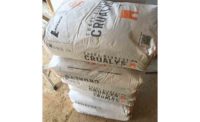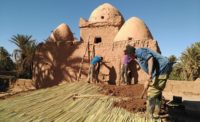I’ve been using natural cements and natural hydraulic limes in the traditional plastering craft for many years. However, I never had the opportunity to visit a quarry where the unique limestones used to produce them are mined.
On a recent visit to Spain and Portugal, I was invited to visit two such quarries, as well as the manufacturing facilities that included the kilns and other equipment used to convert the raw limestone into a lime plaster. The two quarries in Spain and Portugal had completely different geologies and the processes used to prepare the lime were quite different.
In this first article, I’ll discuss what I discovered in Spain where both natural cement and natural hydraulic lime were being produced in close proximity by the same manufacturer, Tigre Natural Cement.
Geology of the Quarries
Tigre Natural Cement has been in continuous operation since 1945. Nevertheless, the tradition of lime production in this area is documented from the 19th century and probably goes back much further than that. The quarries are located near Lleida in the interior and heart of Catalonia region of Spain. Spanish is actually a second language to Catalan here. The terrain is hilly and in the not too distant past, the Eocene age of 55 to 35 million years ago, it was an extensive inland drainage basin for the Ebro River that had yet to break through to the Mediterranean. Refined sediment would be carried by the river and collect at the bottom of these lakes.
In the Ebro basin, much of that sediment was calcareous, that is to say calcium sediment with an additional minor but important percentage of clay. When the Ebro River eventually broke through to the Mediterranean, these inland lakes dried up leaving rock formations known as clayey marls. During the long formation of sedimentation, the marl had accumulated quite a bit of organic matter as well. Mostly that of leaves, the form of which is often still well preserved in the rock.
Because this limestone is purely sedimentary and has not undergone any metamorphic processes of heat or compression it is very soft. I found that I could easily excavate the rock and break it apart by hand which really surprised me. That softness makes mechanical extraction of the limestone at the quarry straight forward. The limestone is chiseled out in rows from a stationary excavator—not unlike a backhoe—but with a massive jack hammer attachment. From there it is scooped up by a front-end loader and delivered to a storage area where the stone is broken down further to appropriate sizes for proper baking in the kilns. Tigre extracts limestone from two quarries in close proximity. The first quarry having both high percentages of alumina and silica produces the natural cement characterized by a rapid initial set. The limestone from the second quarry contains silica as well but very low quantities of alumina and is used to produce the slower setting hydraulic limes.
Baking the Limestone
The baking to convert limestone to lime is called “calcining.” When the temperature in the kiln reaches approximately 1,500 degrees Fahrenheit, the calcium carbonate begins to break down, off-gassing carbon dioxide. If reactive silica and alumina are present in the limestone at higher temperatures, the free lime will then begin to fuse with them to form natural hydraulic lime and natural cement.
Tigre uses traditional vertical kilns that are dug into the side of a hill and lined with fire bricks to bake their limestone. Coke, a clean burning partially processed form of coal, is blended together with the limestone before loading into the kilns. The limestone containing the reactive alumina requires the highest temperatures and the most additional fuel to react. The limestone low in alumina is burned at lower temperatures. By the percentage of fuel added, the temperature can be finely controlled resulting in limes that can be classified either as an NHL 3.5 or an NHL 5. The limestone is laced with ancient organic matter that actually acts as fuel so that a surprisingly small amount of coke is needed. Furthermore, the kilns are kept in continual use so that they never cool, thus conserving energy. The limestone and coke blend added to the top of the kiln makes its way out at the bottom as soft burnt lime rocks ready to be taken to the factory for grinding and bagging.
The Factory
If I’ve given you the impression that Tigre is a big industrial company, that is the farthest thing from the truth. Dad runs the quarry in between checking on his fields where he grows grain. Mom runs the office while the two sons run the factory and lab with one additional employee. This is a real family business. However, that doesn’t mean they’re anything less than professional. Quality control, is in fact, very strict. Every batch burnt in the kiln undergoes a compression test which is recorded, and a sample maintained.
As the name implies, these are natural materials and as they are extracted from the quarry variations will occur. Constant testing gives an opportunity to make subtle adjustments in the manufacturing process to maintain a consistent material. Although, the EU designations of 3.5 and 5 each cover a wide and overlapping range of compression strengths, the specific strength and chemical composition of each and every batch has been tested and can be provided upon request.
Practical Applications
There is a long tradition in Catalonia of using natural cements, natural hydraulic limes or combinations of the two as the basis for mortars, stuccoes and plasters. Today, they are utilized both in restoration works, as well as in new construction. Tigre is constantly looking for ways to make their natural cement and hydraulic limes more useful to the craftsmen who work with them. Recently, they have released a line of ready-mixed mortars based on their natural hydraulic lime. These mortars come pre-blended with aggregates that include limestone, marble and silica sand. Additionally, they use a combination of plant cellulose and pozzolan additions to improve the workability and extend the open time without compromising compressive strength or breathability.
Tigre’s natural cement and natural hydraulic limes have recently made their way to the east coast of the United States where they’ve found immediate application in the historic preservation market. Notable among them is an extensive mortar repointing project at Castle Williams, Governors Island National Monument, New York City. As many of our historic monuments utilized similar materials, it is of incredible benefit to our preservation efforts that a variety of these materials are once again becoming available and critically important for craftsmen to understand how they function and learn best practices when putting them to use. W&C









Report Abusive Comment